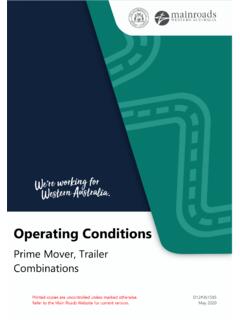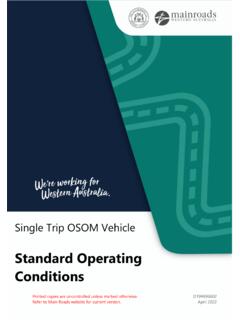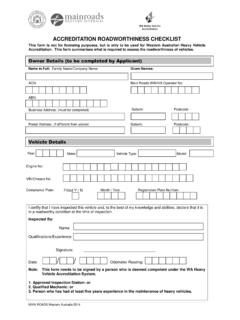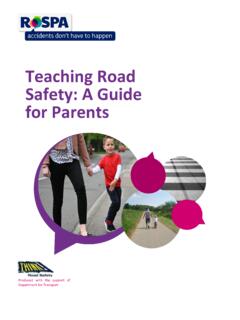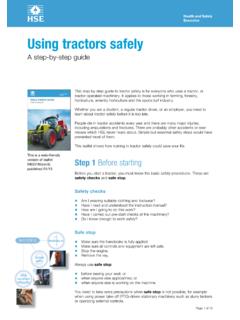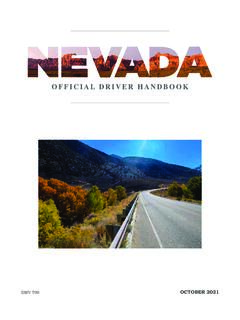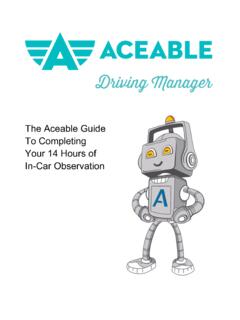Transcription of DRIVING IN WA A GUD TO RST ARAS Driving in Western …
1 DRIVING IN WA A GUIDE TO REST AREASD riving in Western AustraliaA guide to safe stopping placesDRIVING IN WA A GUIDE TO REST AREASD isclaimer: The maps contained within this booklet provide approximate times and distances for journeys however, their accuracy cannot be guaranteed. Main Roads reserves the right to update this information at any time without notice. To the extent permitted by law, Main Roads, its employees, agents and contributors are not liable to any person or entity for any loss or damage arising from the use of this information, or in connection with, the accuracy, reliability, currency or completeness of this of Country 1 About Us 2 Travel Map 2 Roadside Stopping Places 2 Parking bays and rest areas 3 Sharing rest areas 4 Blackwater disposal 5 Changing Places 5 Planning a Road Trip?
2 6 Basic road rules 6 Multi-lingual Signs 6 Safe overtaking 6 Oversize and Overmass Vehicles 7 Cyclones, fires and floods - know your risk 8 Fatigue 10 Manage Fatigue 10 Rest Areas, Roadhouses and Driver Reviver 11 What to do if you breakdown 11 Towing and securing your load 12 Planning to tow a caravan, camper trailer or similar? 12 ContentsSecuring your load 12 Give Animals a Brake 13 Travelling with pets? 13 DRIVING on remote and unsealed roads 14 Unsealed Roads 14 Litter 15 Useful contacts 16 Our Regions 17 Perth Metropolitan Area 18 Kimberley 20 Pilbara 22 Mid-West Gascoyne 24 Wheatbelt 26 Goldfields Esperance 28 South West 30 Great Southern 32 Route Maps 34 DRIVING IN WA A GUIDE TO REST AREAS 1 Acknowledgement of Country The Government of Western Australia acknowledges
3 The traditional custodians throughout Western Australia and their continuing connection to the land, waters and community. We pay our respects to all members of the Aboriginal communities and their cultures; and to Elders both past and IN WA A GUIDE TO REST AREASA bout UsMain Roads represents one of the world s most expansive road networks. We care about providing world class outcomes for our customers through a safe, reliable and sustainable road-based transport system. Our regional offices located in Albany, Bunbury, Narrogin, Northam, Kalgoorlie, Geraldton, Carnarvon, Port Hedland, Derby, Broome and Kununurra deliver services with, and for the community, to ensure the best possible DRIVING experience on our have designed this guide to help make your trip across Western Australia (WA) smoother, safer and more enjoyable.
4 If you would like to provide your comments or feedback, please email us at or call 138 MapKnow before you go! Our online Travel Map provides you with the latest road incident and impact information you need to plan Parking bays and rest areasAcross WA you ll find: Mor e than 900 parking bays (minor rest areas) which provide a safe place to stop Ar ound 500 stops that offer basic facilities such as a toilet, table, shelter or bin; these are primarily designed to cater for motorists to stop and rest for a short perioda safe and efficient trip across Western Australian roads.
5 Plan your trip now - the map to find find rest areas and amenities including toilets, accessible toilets, roadhouses, heavy vehicle parking, picnic facilities and Stopping PlacesA roadside stopping place is an area beside the road designed to provide a safe place for vehicles to pull over in the event of an emergency. Stopping places can also double as special stops for rest areas, scenic lookouts, information bays or road-train assembly. 32 Over 200 heavy vehicle rest areas that are designed to allow heavy vehicle drivers to carry out short, purpose-based stops including load checks, completing logbooks and addressing associated operational needs.
6 Overnight stays may be allowed in some heavy vehicle rest areas (look for the signs) 70 r est areas that allow overnight stays (stopping is not to exceed more than 24 consecutive hours)Main Roads, we care about keeping WA movingiDRIVING IN WA A GUIDE TO REST AREASS haring Rest AreasBy law, heavy vehicle operators have to stop each day. Heavy Vehicle Rest Areas on our network are specifically designed to cater for this requirement and provide truckies with a safe spot to carry out load checks, complete their log book or take a compulsory rest you are intending to stop or camp in a 24-hour rest area overnight, please be courteous park up on the side of the rest area, set up off the road-way and be sure to leave enough room for our truckies to safely enter, get the rest they need, and DisposalBlackwater, which includes waste water and sewage.
7 May only be disposed of in rest area displaying the effluent dump site sign, shown here. If a dump site is not available, it must be taken to the nearest town dump site. Waste should not be dumped into river water catchments or toilets on PlacesChanging Places provide suitable facilities for people who cannot use standard accessible toilets. A number of Changing Places can only be accessed using a Master Locksmiths Access Key (MLAK) to ensure they are used by the people who require specialised facilities provide: height-adjustable adult-sized change tables a constant-charging ceiling track hoist system a centrally-located peninsula toilet an automatic door with a minimum 950 mm clear opening priv acy screensFor more information about the MLAK system or, to download a MLAK application form, visit find your nearest Changing Places visit 54 Remember to be mindful when sharing rest areas with heavy and oversize vehicles, and don t over-stay your 24 hour dump sitePhotos courtesy of Changing Places and The Shire of IN WA A GUIDE TO REST AREASP lanning a Road Trip?
8 Basic Road RulesIf you re new to DRIVING on WA s roads or not, we encourage you to review the State s road rules and penalty information before you set off. Fines and/or the loss of demerit points are applicable if you are caught breaking the contributes to around 60 deaths at police-attended crashes on our roads each year. The fact is the faster you travel, the longer it takes to stop, and more fatalities occur on our open roads than anywhere else in you are permitted to touch a mobile phone only if secured in a mounting affixed to your vehicle to accept or end a phone call, using your mobile phone while DRIVING to text, email, use social media, take a photo or video is drivers and passengers must sit in a seat that has a seatbelt available and the seatbelt must be fastened and worn correctly.
9 Child car restraints are also mandatory for children from birth to seven years of for more information on speeding, mobile phone use, drink and drug DRIVING , seatbelts, double demerits, red lights and SignsYou might spot some multilingual advisory signs on your journey, designed to help international drivers safely navigate the State s most popular tourist signs have been produced in German, French and Simplified Mandarin to remind drivers to keep left when DRIVING in Australia. NEVER overtake on a curve or hill where visibility is reduced Only return to the left hand side of the road when you can see the road-train s headlights in your rear view mirror and remember to indicate before moving back never cut off a road-train as they can t stop quickly If y ou can, use your UHF radio to call through to the vehicle in front of you on Channel 40 Y ou say: Copy in PM12 They reply: Copy that Y ou say: I am in the vehicle behind you, could you let me know when it is clear and safe to pass?
10 And be prepared to pass when the driver advises They reply: Copy caravan behind PM12, it s clear to go Y ou say: Copy that, we are on our way DRIVING IN WA A GUIDE TO REST AREAS 76 Did you know that some of our road-trains are up to 60 metres long? That equates to 11 car lengths!iRemember, while you can use a UHF or CB radio while DRIVING , you must remain in full control of your vehicle while doing soThere are also penalties for the misuse of emergency channels on the UHFO versize and Overmass VehiclesSometimes, you might encounter a heavy vehicle carrying a large, wide load.



